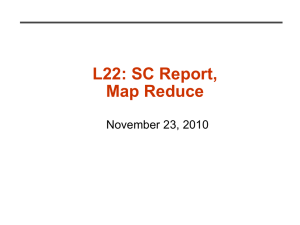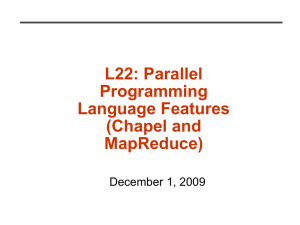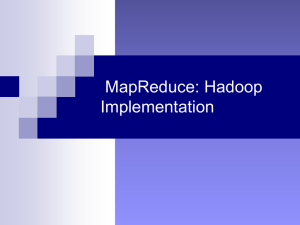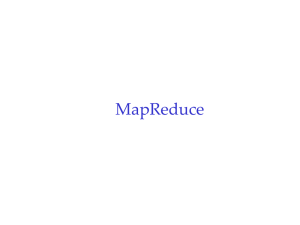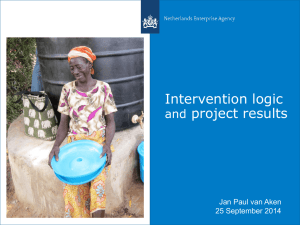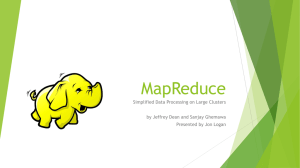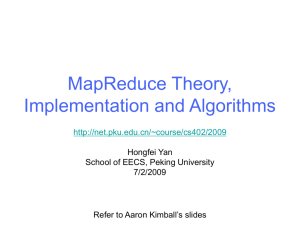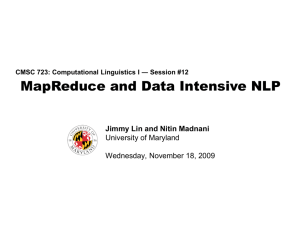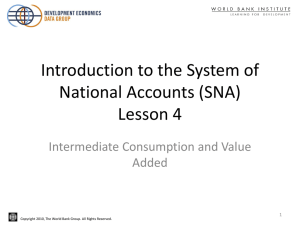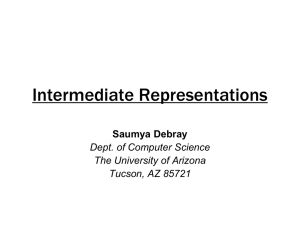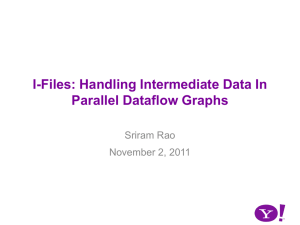MapReduce - Ahmet Sayar
advertisement
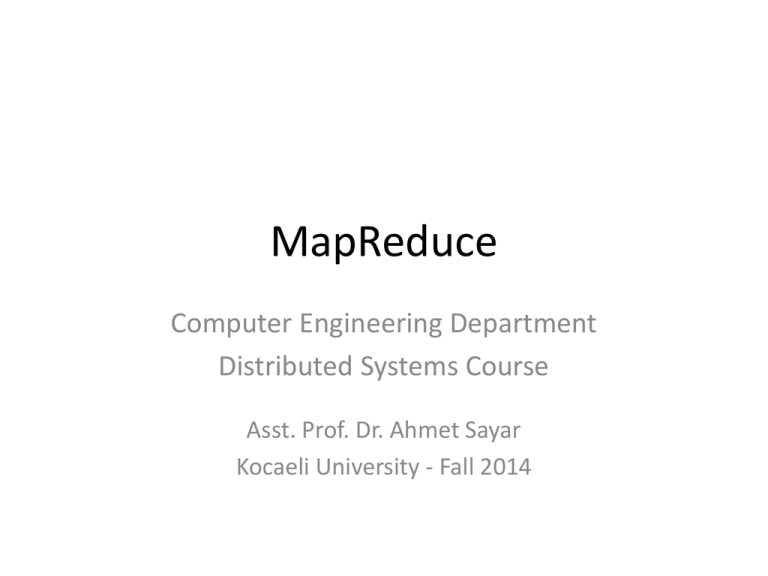
MapReduce Computer Engineering Department Distributed Systems Course Asst. Prof. Dr. Ahmet Sayar Kocaeli University - Fall 2014 What does Scalable Mean? • Operationally – In the past: works even if data does not fit in main memory – Now: can make use of 1000s of cheap computers • Algorithmically – In the past: if you have N data items, you must do no more than Nm operations – polynomial time algorithms – Now: if you have N data items, you should do no more than Nm / k operations, for some large k • Polynomial time algorithms must be parallelized – Soon: if you have N data items, you should do no more than N logN operations Example: Find matching DNA Sequences • Given a set of sequences • Find all sequences equal to “GATTACGATTATTA” Sequential (Linear) search • Time = 0 • Match? NO Sequential (Linear) search • 40 Records, 40 comparison • N Records, N comparison • The algorithmic complexity is order N: O(N) What if Sorted Sequences? • GATATTTTAAGC < GATTACGATTATTA • No Match – keep searching in other half… • O(log N) New Task: Read Trimming • Given a set of DNA sequences • Trim the final n bps of each sequence • Generate a new dataset • Can we use an index? – No we have to touch every record no matter what. – O(N) • Can we do any better? Parallelization O(?) New Task: Convert 405K TIFF Images to PNG Another Example: Computing Word Frequency of Every Word in a Single document There is a pattern here … • A function that maps a read to a trimmed read • A function that maps a TIFF image to a PNG image • A function that maps a document to its most common word • A function that maps a document to a histogram of word frequencies. Compute Word Frequency Across all Documents (word, count) MAP • How to split things into pieces – How to write map and reduce REDUCE Map Reduce • Map-reduce: high-level programming model and implementation for large-scale data processing. • Programming model is based on functional programming – Every record is assumed to be in form of <key, value> pairs. • Google: paper published 2004 • Free variant: Hadoop – java – Apache Example: Upper-case Mapper in ML Example: Explode Mapper Example: Filter Mapper Example: Chaining Keyspaces • Output key is int Data Model • Files • A File = a bag of (key, value) pairs • A map-reduce program: – Input: a bag of (inputkey, value) pairs – Output: a bag of (outputkey, value) pairs Step 1: Map Phase • User provides the Map function: – Input: (input key, value) – Output: bag of (intermediate key, value) • System applies the map function in parallel to all (input key, value) pairs in the input file Step 2: Reduce Phase • User provides Reduce function – Input: (intermediate key, bag of values) – Output: bag of output (values) • The system will group all pairs with the same intermediate key, and passes the bag of values to the reduce function Reduce • After the map phase is over, all the intermediate values for a given output key are combined together into a list • Reduce() combines those intermediate values into one or more final values for that same output key • In practice, usually only one final value per key Example: Sum Reducer In summary • Input and output : Each a set of key/value pairs • Programmer specifies two function • Map(in_key, in_value) -> list(out_key, intermediate_value) – Process input key/value pair – Produces set of intermediate pairs • Reduce (out_key, list(intermediate_value)) -> list(out_value) – Combines all intermediate values for a particular key – Produces a set of merged output values (usually just one) • Inspired by primitives from functional programming languages such as Lisp, Scheme, and Haskell Example: What does this do? • Word count application of map reduce Example: Word Length Histogram Example: Word Length Histogram • Big = Yellow = 10+letters • Medium = Red = 5..9 letters • Small = Blue = 2..4 letters • Tiny = Pink = 1 letter More Examples: Building an Inverted Index • Input • Desired output • Tweet1, (“I love pancakes for breakfast”) • Tweet2, (“I dislike pancakes”) • Tweet3, (“what should I eat for breakfast”) • Tweet4, (“I love to eat”) • “pancakes”, (tweet1, tweet2) • “breakfast”, (tweet1, tweet3) • “eat”, (tweet3, tweet4) • “love”, (tweet1, tweet4) More Examples: Relational Joins Relational Join MapReduce: Before Map Phase Relational Join MapReduce: Map Phase Relational Join MapReduce: Reduce Phase Relational Join in MapReduce, Another Example MAP: REDUCE: Simple Social Network Analysis: Count Friends MAP SHUFFLE Taxonomy of Parallel Architectures Cluster Computing • Large number of commodity servers, connected by high speed, commodity network • Rack holds a small number of servers • Data center: holds many racks • Massive parallelism – 100s, or 1000s servers – Many hours • Failure – If medium time between failure is 1 year – Then, 1000 servers have one failure / hour Distributed File System (DFS) • For very large files: TBs, PBs • Each file is partitioned into chunks, typically 64MB • Each chunk is replicated several times (>2), on different racks, for fault tolerance • Implementations: – Google’s DFS: GFS, proprietary – Hadoop’s DFS: HDFS, open source HDFS: Motivation • Based on Google’s GFS • Redundant storage of massive amounts of data on cheap and unreliable computers • Why not use an existing file system? – Different workload and design priorities – Handles much bigger dataset sizes than other file systems Assumptions • High component failure rates – Inexpensive commodity components fail all the time • Modest number of HUGE files – Just a few million – Each is 100MB or larger; multi-GB files typical • Files are write-once, mostly appended to – Perhaps concurrently • Large streaming reads • High sustained throughput favored over low latency Hdfs Design Decisions • Files are stored as blocks – Much larger size than most filesystems (default is 64MB) • Reliability through replication – Each block replicated across 3+ DataNodes • Single master (NameNode) coordinates access, metadata – Simple centralized management • No data caching – Little benefit due to large data sets, streaming reads • Familiar interface, but customize API – Simplify the problem; focus on distributed apps Based on GFS Architecture Referanslar • https://class.coursera.org/datasci-001/lecture • https://www.youtube.com/watch?v=xWgdny1 9yQ4
